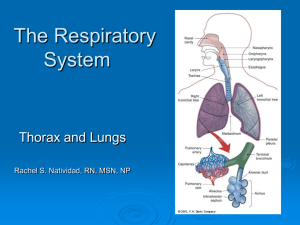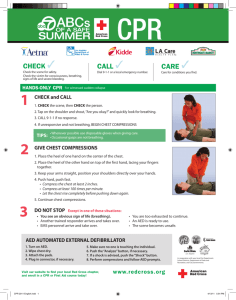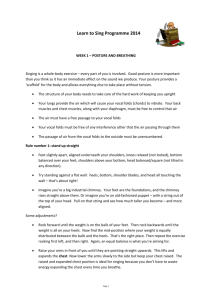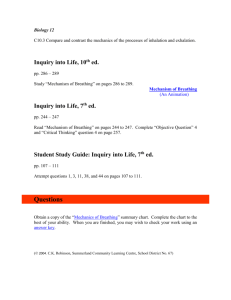投影片 1
advertisement
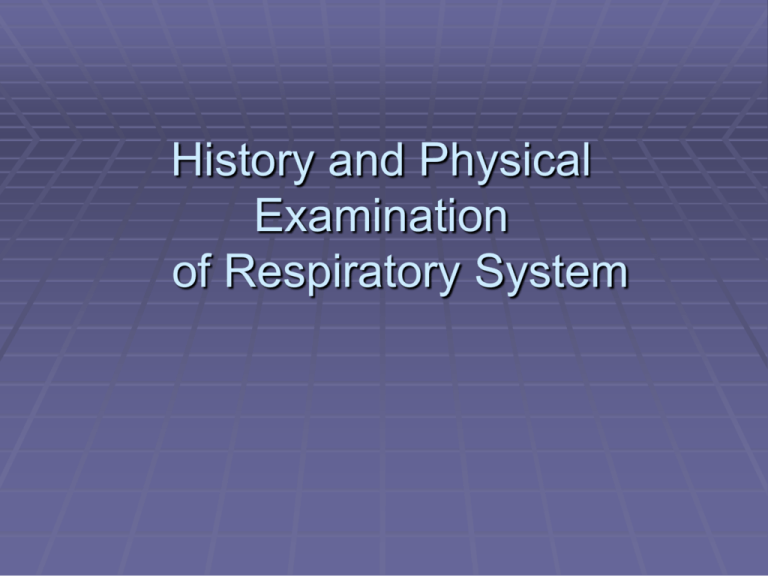
History and Physical Examination of Respiratory System Chest Pain ***Pulmonary – primary and referred Primary – parietal pleura, major airway, chest wall, diaphragm, mediastinal Referred to – ant: upper abdominal wall - base of the neck and shoulder(C3,4,5) Chest pain Pleural pain ( pleurodynia) Intercostal neuritis Muscular pain Costochondral –Tietze’s syndrome Esophageal Cardiac Pericardiac Aortic Cough Productive/ nonproductive Acute ( < 3 weeks) – infection, pul embolism, CHF Chronic – smoker, COPD, bronchogenic cancer Nonsmoker,not ACEI- asthma, PND, GERD Sputum type - foul smelling - abundant,frothy,saliva like - copious purulent,position change Hemoptysis Massive - >100-600 cc/ 24hr Bright red, alkaline TB, bronchiectasis – massive Bronchitis, tumor – slight 30 % unknown vasculitis, bleeding tendency Clues From the History Tobacco Abuse Tobacco-related diseases make up ~40% of all cardiopulmonary symptoms. ( # pack/day )x( # year smoked) = pack-year. >15 pack-years: ‘ed cardiovascular risk. >30 pack-years: ‘ed risk of COPD, lung cancer. Opportunity to counsel on smoking cessation. ASK ADVICE ASSIST ARRANGE Examination of the Chest INSPECTION Landmarks Deformities of the chest Breathing patterns Intercostal retractions Cheyne-Stokes breathing Ataxic breathing Systemic signs Clubbing and cyanosis Systemic Signs of Pulmonary Disease Clues to Increased Work of Breathing Nasal flaring. Intercostal/supraclavicular retractions. Accessory muscle use. Pursed-lipped breathing. Disrupted speech. Thoraco-abdominal dissociation. Visual Examination of the Chest Breathing Patterns Rate, Depth, Regularity Normal Ataxic breathing Adults:12-20/min Infants: 44/min Biot’s breathing Irregularly irregular e.g., brain medullary injury Tachypnea Rapid, shallow breathing Cheyne-Stokes breathing Hyperypnea Regular rate, irregular depth MAY be normal e.g., heart failure Rapid, deep breathing Hyperventilation Kussmaul breathing (metabolic acidosis) Sighs Bradypnea Hyperventilation syndrome 1 sigh per 200 breaths Systemic Signs of Pulmonary Disease Clubbed Fingers Tactile Examination of the Chest “Feeling” the Breath Symmetry Pattern of expansion Areas of tenderness Auscultation of the Chest Breath Sound Characteristics Intensity of Pitch of Duration Expiratory Expiratory of sounds Sounds Sounds Vescicular Inspiration > Expiration Relatively low Both lung fields Intermediate 1st & 2nd interspaces anteriorly; between scapulae Loud Relatively high Over manubrium (?) Very Loud Relatively high At sternal notch Softer Broncho- Inspiration Intermediate vescicular = Expiration Inspiration Bronchial < Expiration Tracheal Inspiration = Expiration “Normal” Location Adventitious Sounds in the Chest Rales (“crackles”) Wheezes & rhonchi. Stridor Pleural rub. Mediastinal crunch (“Hamman’s sign”). Adventitious Sounds in the Chest Rales (Crackles) Discontinuous sounds, sudden opening of small airways. High-pitched: fine crackles Low-pitched: coarse crackles Pneumonia, fibrosis, early congestive heart failure, bronchitis, bronchiectasis. Adventitious Sounds in the Chest Wheezes and Rhonchi Bernoulli principal. Continuous sounds. Wheezes, high pitched (ca 400 Hz), suggests narrowed airways in asthma, COPD, or bronchitis. Rhonchi, low pitched (ca 200 Hz), suggests secretion in large airways. Transmitted Voice Sounds Egophony & Whispered Pectoriloquy Egophony: E→A change Whispered pectoriloquy: loudered, clearer whispered sounds Heard through an airless lung (consolidation, lobar pneumonia)

